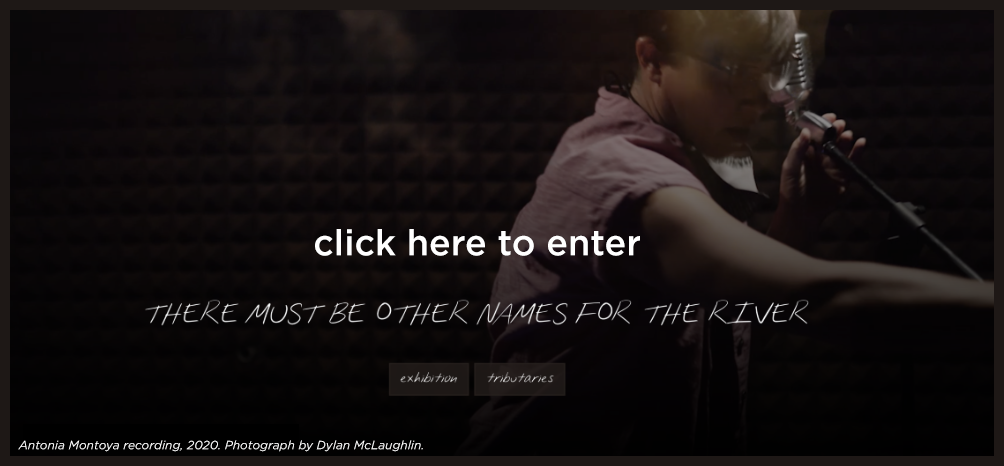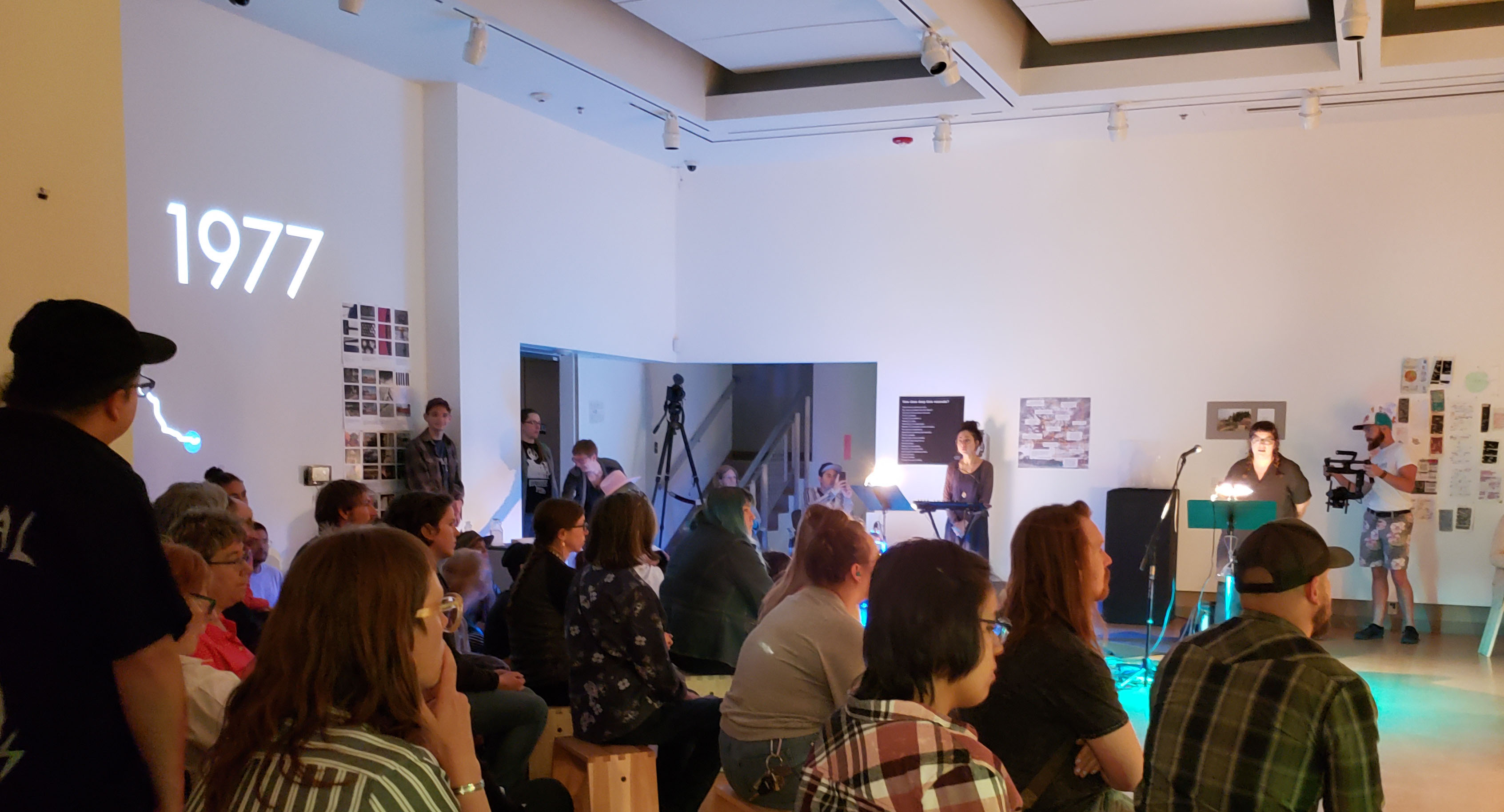The river is the reason we can live in this part of the arid high desert. It’s why there are animals and plants, villages and cities.
And it’s drying up.
In 2020, through stretches of Albuquerque and elsewhere, the river was shallow and skinny, if not disappearing altogether for miles and miles. Hydrologists say it could be dry this year from north of Bernalillo through Albuquerque. These miles of empty riverbed are new and alarming. Water agencies in New Mexico are warning farmers not to plant crops in 2021, since there may not be water to maintain them.
Human-caused climate change over the last few decades—the blink of an eye in the river’s ancient timeline—is one culprit. Another is human interference with its flows, the damming and trading and control of water, a resource that’s become more valuable than gold.
There Must Be Other Names For The River is a composition for singers who embody river flow data at six points along what we call the Rio Grande. The exhibition features a web-based sound installation and virtual community space titled “Tributaries,” where viewers can contribute their voice to the project. The piece engages our relationship with this source of life in this region, and in a time of physical distancing, acknowledges that the river is also a way we are connected with neighbors and ecosystems, seen and unseen.
The United Nations declared March 22 World Water Day to advocate for sustainable freshwater resources. In recognition of the imperative for fresh, accessible water for all, artists Marisa Demarco, Dylan McLaughlin and Jessica Zeglin are releasing the online participatory installation of their composition on World Water Day. This work—through visceral re-connection and acknowledgement—aims to spur the questions that must be asked so we can make demands of governments and industry to save this river. Because though both would pressure impacted people and communities to use less water, if you look at the big picture of water losses, this is about control, policy and industrial regulation. The river that we call the Rio Grande—but which has been called by many names throughout its long life—must survive long into the future.
This is song. This is a fight.
Upon entering the website, select “exhibition” to view the installation or select “tributaries” to contribute to the project.
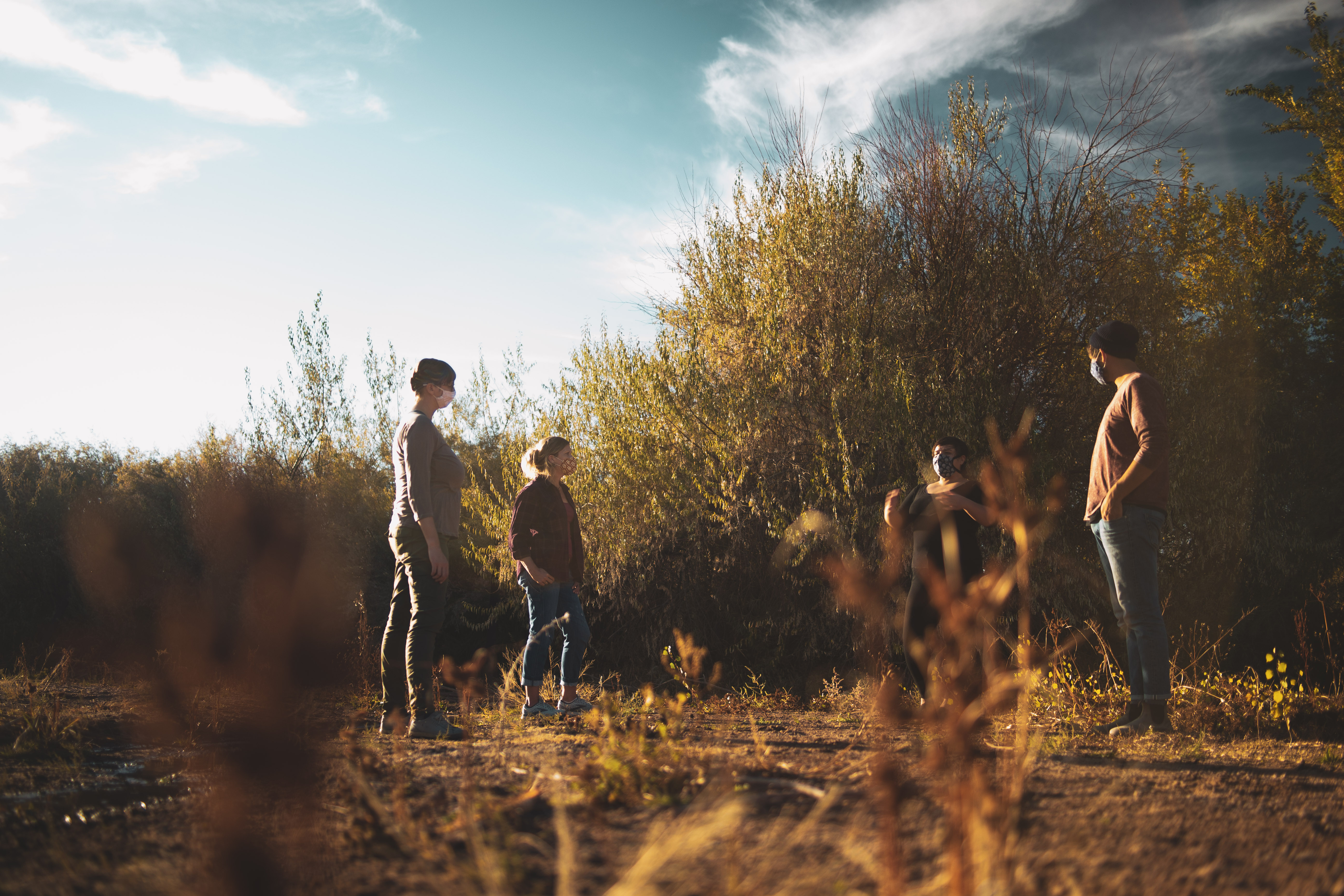
The Artists
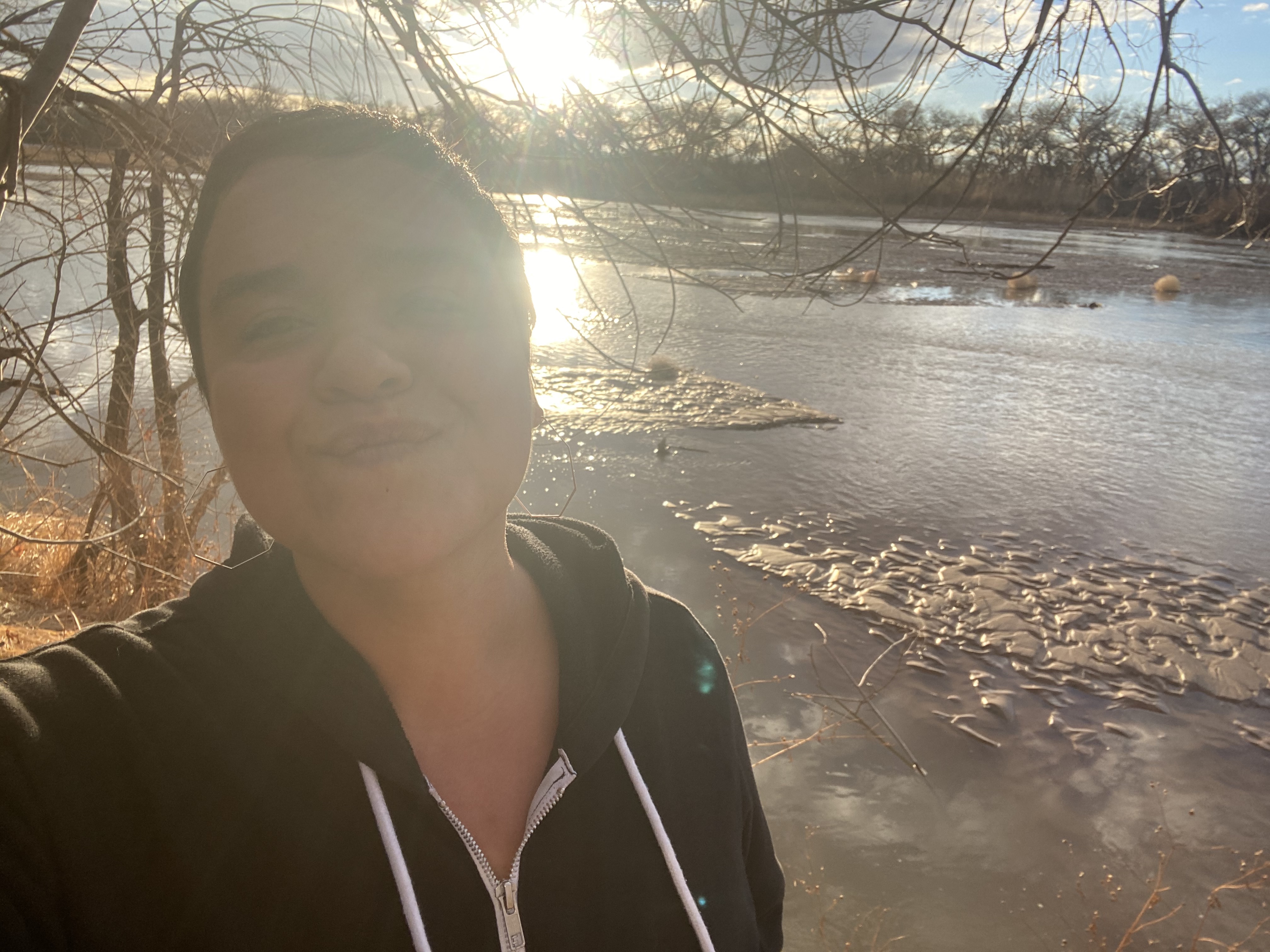
Marisa Demarco is a musician, performance and installation artist, composer and journalist based in Albuquerque, N.M.
She’s the founder of Gatas y Vatas festival for boundary-pushing performance and Milch de la Máquina, a performance art crew. She’s a leader with Death Convention Singers, the largest noise collective in the Southwest, and she performs solo as Bigawatt. She also teaches Sound Art at the University of New Mexico and leads workshops on small electronics projects.
Demarco will create a sound and video installation and performance for the Museo de Arte de Ciudad Juarez in the coming year and a sound installation at the National Hispanic Cultural Center centered on endurance strategies. She’s a SITE scholar, and her work is in the museum through early March 2021 as part of the exhibition “There is a crack in everything, that’s how the light gets in.” In 2020, she performed virtually as part of the 22nd annual High Zero festival.
Demarco is longtime a news reporter and producer for public radio, spending much of her career focused on criminal legal reform and public health. And she’s an MFA candidate at the University of New Mexico’s Experimental Art + Technology Program.
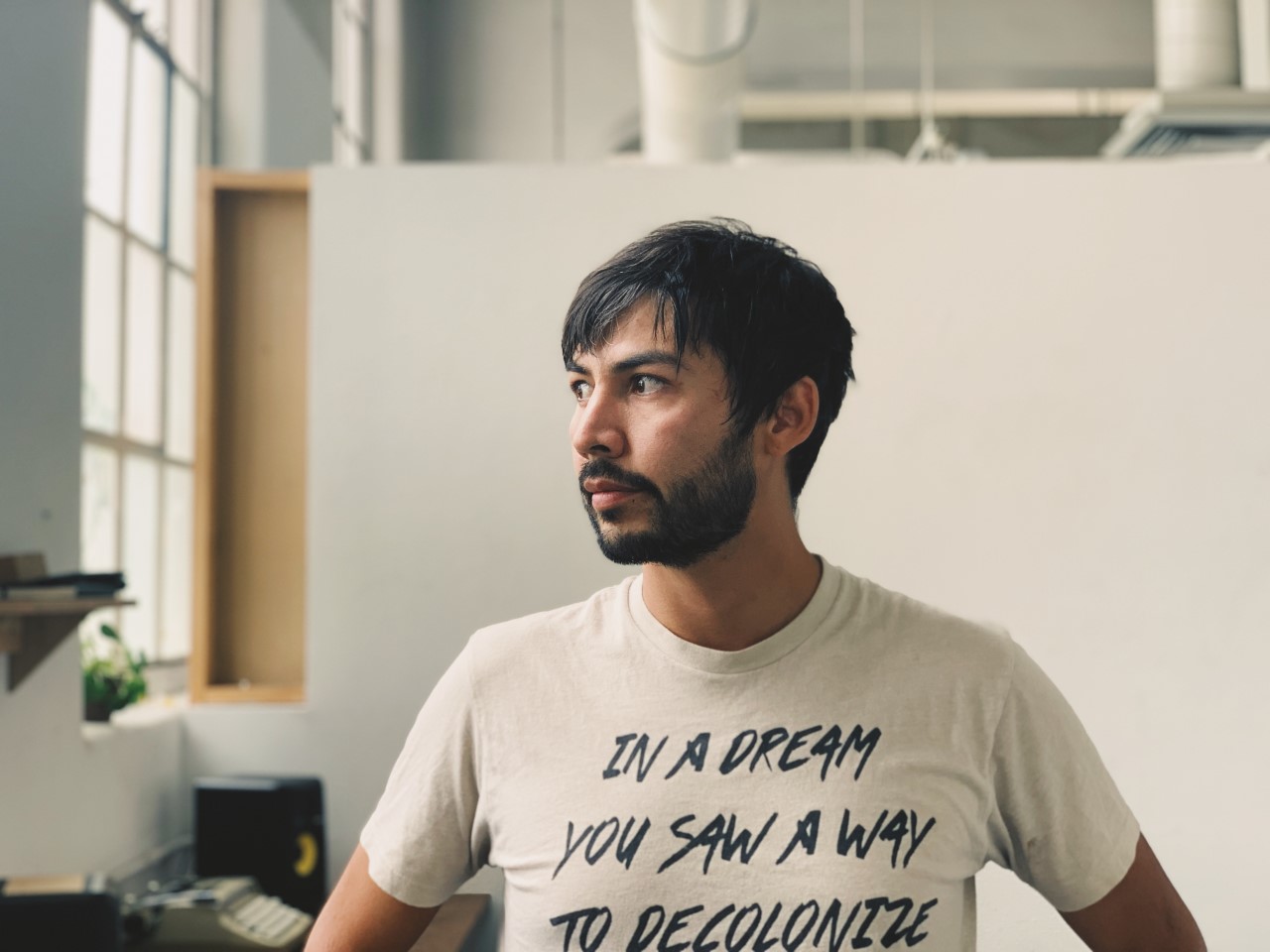 Dylan McLaughlin is a sound and video artist, storyteller, and educator currently living and working in Albuquerque, New Mexico. Looking to sites of extraction, his work explores forms of witness and implication. In his multi-media installation, interactive, and performative works, McLaughlin looks to engage the poetics and politics of landscape formation and human affect.
Dylan McLaughlin is a sound and video artist, storyteller, and educator currently living and working in Albuquerque, New Mexico. Looking to sites of extraction, his work explores forms of witness and implication. In his multi-media installation, interactive, and performative works, McLaughlin looks to engage the poetics and politics of landscape formation and human affect. Jessica Zeglin is an artist, gardener, and educator currently based in the middle Rio Grande valley. Her works in sound, drawing, textiles, and installation are grounded in theories of emergence, where complex patterns emerge from simple building blocks. Her research- and place-based craft addresses threatened ecosystems and cultural-ecosystem interactions, emphasizing listening, attentiveness, and tending practices that bridge biological and conceptual divides.
Jessica Zeglin is an artist, gardener, and educator currently based in the middle Rio Grande valley. Her works in sound, drawing, textiles, and installation are grounded in theories of emergence, where complex patterns emerge from simple building blocks. Her research- and place-based craft addresses threatened ecosystems and cultural-ecosystem interactions, emphasizing listening, attentiveness, and tending practices that bridge biological and conceptual divides.
Zeglin’s work has been shown at Trapdoor Projects and Birds+Richards Gallery in Albuquerque, NM, the Weisman Art Museum in Minneapolis, MN, and the Tamarind Institute Gallery. She has exhibited public place-based installations in Arizona, New Mexico, Minnesota, and Kansas, gathered soundscapes from the dry playas of Central Oregon and led listening walks through remnant tallgrass prairie in Eastern Kansas. She holds a Master of Fine Arts in Art and Ecology from the University of New Mexico, a Master of Public Health from the University of Minnesota, and is the recipient of the PLAYA and Tallgrass Artist Residencies as well as a Sevilleta Long Term Ecological Research program fellowship.
The artists would like to thank the University of New Mexico Art Museum and the University of New Mexico Center for Environmental Arts and Humanities for their generous support of this work. Particular thanks to Arif Khan, Traci Quinn, Lee Montgomery, Nina Elder, and Subhankar Banerjee, who supported this work from its inception as a student project through its multi-year development into a digital installation. Thank you to Devin Geraci and all UNM Art Museum staff for their assistance, and to James Johnson and Mindshare Labs for website development. We would also like to thank 516 Arts—Suzanne Sbarge, Claude Smith, Viola Arduini, and Mackensie Lewis—and the National Hispanic Cultural Center for their support of previous iterations of this work. Much gratitude and thanks to Kevin Michael Maestas and New Mexico PBS for allowing us to use Maestas’ aerial footage of the dry river in the exhibition. Thank you to David Beining and the University of New Mexico ARTS Lab for providing a safe studio recording space during the pandemic, and Manny Rettinger and Liz Rincon from the Music Department for helping with equipment during live performances. Thank you to Roman Garcia at KUNM Radio for loaning us microphones and other recording equipment.
Thank you to Laura Paskus, whose environmental reporting inspired this work.
Thank you to musicians Monica Demarco, Ryan Dennison, Antonia Montoya, Mauro Woody, Jessica Chao, Kenneth Cornell and Marya Errin Jones for their profound interpretations of the graphic score.
Thank you to the Albuquerque singers who kicked off what in pre-pandemic times was to be an in-person version of this work, keeping us warm with your song during a cold day along the river: Celia Ameline, bug carlson, Hannah Colton, Austin Fisher, nicholas b jacobsen, Becki Jones, Keegan Kloer, Lazarus Letcher, Ana Alonso Minutti, Tanya Nuñez, Peri Pakroo, Quela Robinson, Anna Rutins, and Maggie Siebert.
As we listen to this piece, we hold Hannah Colton and her community, friends and family closely in our hearts. We love and miss you, Hannah.
There Must Be Other Names For The River was performed for an audience at the UNM Art Museum on April 19, 2019.
Please be sure to credit artists’ work using the included image credit guide. Contact Devin Geraci, UNMAM Marketing Manager (dgeraci@unm.edu), or the artists (othernamesfortheriver@gmail.com) for any further inquiries or requests.
Click to download:

